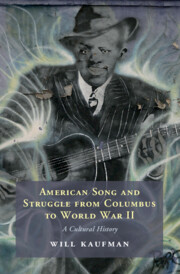Book contents
- American Song and Struggle from Columbus to World War II
- American Song and Struggle from Columbus to World War II
- Copyright page
- Praise for American Song and Struggle
- Dedication
- Contents
- Figures
- Preface
- Acknowledgments
- Introduction
- Chapter 1 Broken Spears and Songs of Sorrow
- Chapter 2 Good Newes from Virginia
- Chapter 3 A Capital Chop
- Chapter 4 If I Had but a Small Loaf of Bread
- Chapter 5 Where Today Are the Pequot?
- Chapter 6 There Is a Fountain Filled with Blood
- Chapter 7 A Tragedy That Beggared the Greek
- Chapter 8 Muscle, Blood, and Steel
- Chapter 9 Rule Anglo-Saxia
- Chapter 10 The Hand That Feeds You
- Chapter 11 We Are Many
- Chapter 12 100% American
- Chapter 13 We’re Up Against It Now
- Chapter 14 The Panic Is On
- Chapter 15 To Thee We Sing
- Conclusion
- Notes and Sources
- Song Index
- General Index
Chapter 5 - Where Today Are the Pequot?
Published online by Cambridge University Press: 30 July 2022
- American Song and Struggle from Columbus to World War II
- American Song and Struggle from Columbus to World War II
- Copyright page
- Praise for American Song and Struggle
- Dedication
- Contents
- Figures
- Preface
- Acknowledgments
- Introduction
- Chapter 1 Broken Spears and Songs of Sorrow
- Chapter 2 Good Newes from Virginia
- Chapter 3 A Capital Chop
- Chapter 4 If I Had but a Small Loaf of Bread
- Chapter 5 Where Today Are the Pequot?
- Chapter 6 There Is a Fountain Filled with Blood
- Chapter 7 A Tragedy That Beggared the Greek
- Chapter 8 Muscle, Blood, and Steel
- Chapter 9 Rule Anglo-Saxia
- Chapter 10 The Hand That Feeds You
- Chapter 11 We Are Many
- Chapter 12 100% American
- Chapter 13 We’re Up Against It Now
- Chapter 14 The Panic Is On
- Chapter 15 To Thee We Sing
- Conclusion
- Notes and Sources
- Song Index
- General Index
Summary
The Mexican–US War ends with the top half of Mexico – and its people – subsumed into the voracious US empire. A new musical genre – the Corrido – emerges from the new borderlands. The California Gold Rush produces a wealth of song from as far east as Scandinavia and as far west as China. US nativists sing against the arriving Germans and Irish Catholics, but they reserve their greatest musical venom for the Chinese in the form of the “John Chinaman” minstrel stereotype. Against such vicious representations, we have the Songs of Gold Mountain to reflect the true humanity of Chinese immigrants. In the wake of the Seneca Falls Convention, songs of women’s suffrage resound across the landscape, including those of Sojourner Truth. The Hutchinson Family Singers become the first US “supergroup” with their abolition songs, and Black challenges to the minstrelsy of E. P. Christy, Stephen Foster, and others continue, not only through the oratory of Frederick Douglass and songs of the Underground Railroad, but also through the operatic accomplishments of Elizabeth Taylor Greenfield.As the country careens toward the irrepressible schism of civil war, song becomes a highly supercharged, sectional arena.
Keywords
- Type
- Chapter
- Information
- American Song and Struggle from Columbus to World War 2A Cultural History, pp. 87 - 110Publisher: Cambridge University PressPrint publication year: 2022

